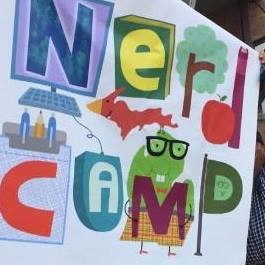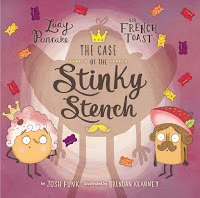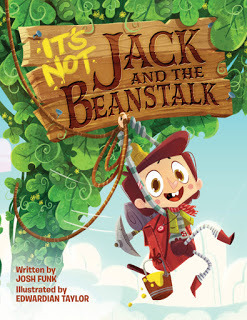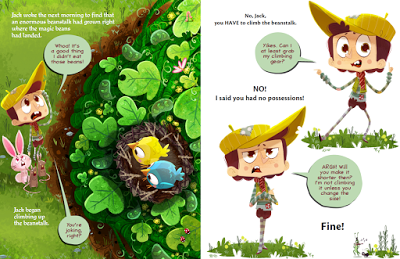Friday Feedback: Josh Funk & The Read Aloud Picture Book
Hey, all,
 Just back from one of those totally inspiring few days spent in the nerdy world of #nErDcampMI, where I even hosted an impromptu session on Teachers Write! so we have a bunch of amazing new campers, and I hope they're peeking in here.
Just back from one of those totally inspiring few days spent in the nerdy world of #nErDcampMI, where I even hosted an impromptu session on Teachers Write! so we have a bunch of amazing new campers, and I hope they're peeking in here.A few times over those days, I crossed paths with my friend, Josh Funk, who told me more than once how excited he is to be hosting Friday Feedback this week.
I'm excited too. Not only do I know I have many aspiring picture book writers here who like to participate, but his post is amazing and inspiring and informative! Since, I'm never the best one to give picture book advice -- hey, I'd still like to write my own one day but have no idea how! -- I'm super excited he agreed to guest host!
If you post non-picture book excerpts -- and of course feel free to! -- I will do my usual chiming in in the comments, but otherwise, I'm going to leave it all up to him! You couldn't be in better hands. (And if you're new here, and before you proceed, please take a moment to click this link to read the Friday Feedback RULES):
 Photo Credit: Carter Hasegawa
Photo Credit: Carter HasegawaSo, without further ado, here is the awesome Josh Funk, author of LADY PANCAKE & SIR FRENCH TOAST, THE CASE OF THE STINKY STENCH, and wonderful forthcoming titles like IT'S NOT JACK AND THE BEANSTALK. Be sure to check them all out and order them in to your libraries and classrooms if you don't already have them (are you crazy?!)!

See you in the comments. Here's Josh:
Hooray! It’s Friday of Week 1!
I’m thrilled that Gae & Co. invited me to join in #TeachersWrite - and I’m so excited to be able to share a work in progress, for your feedback.
First, I’d like to say - WOW! I don’t know how you do it. You educators work 80-100 hour weeks … AND you write! I’m not a teacher, but I’m married to one - and I can emphatically (and empathetically) say that you have the hardest job there is (hopefully it’s also an emotionally and psychologically rewarding job, too).
But (oops - sorry) you don’t want to think about school. It’s summer! Let’s write!
Gae tells me there are many of you interested and working on picture books! Great! Before we start, I want to go over a few basics by defining what a picture book actually is. At its core, there are four components, as I see it. A picture book is:
1. A Story2. With Illustrations3. For Children4. Meant to Be Read Aloud
Yes, there are exceptions to all of the above (concept books and poems might not have narrative, The Book with No Pictures, parodies for adults, and early readers). But I believe that for the most part, the above applies.
What I’d like to focus on today is #4 - A picture book is meant to be read aloud - and usually read out loud by an adult to a child. We, the parents, teachers, librarians, and all adult readers have to perform picture books in front of children.
I know not everyone is a born thespian, but the best picture books (in my opinion) make it very easy for the adult reader to play act. In fact, one of the exceptions above, BJ Novak’s The Book with No Pictures, does a great job of forcing the reader to perform.
So I decided to write my own book that forced the reader to really get into character. If you know me, you’ll know most of my picture books are in rhyme. But my first non-rhyming picture book is coming out this September - It’s Not Jack and the Beanstalk .

Yes, it’s a fractured fairy-tale, but not just a fractured fairy-tale - it’s a META -fractured-fairy-tale. Jack doesn’t want to do to what the reader says - and all the reader wants to do is tell the traditional story. So you, the adult reader, get to argue with characters in the book (and they argue back).
Here are a few samples pages to give you the picture (images courtesy of Two Lions, art by Edwardian Taylor):
 Jack - Pages 14-15
Jack - Pages 14-15 Jack - Pages 20-21
Jack - Pages 20-21The story evolved in script form, as my kids and I would read it out loud to friends and family members (the kids playing Jack and the Giant, while I played the storyteller). And while it wasn’t a motivating factor as I was writing the story, I do think it would make for a fun reader’s theater.
And. . . since it's Friday FEEDBACK, the writing sample I’m sharing today is from a follow-up manuscript called It’s Not Hansel and Gretel . The story is told by the same reader/narrator whose only goal is to tell the traditional story. I intend it to be the same format with colored speech bubbles for each of the characters. The section below starts on the third spread of the story:
Page 10-11When the sky grew dark, Papa ran off.Hansel: Gretel, I’m worried.Gretel: Don’t fret, Hansel. I’m sure Papa will be right back with blankets and a bit of food. Our parents love us.No! He’s not coming back!
Luckily, Hansel had left a trail of breadcrumbs leading back to home.Hansel: Breadcrumbs? I didn’t bring any breadcrumbs.Gretel: What kind of person saves breadcrumbs?I … don’t really … know.Hansel: It’s a time of great famine. If there are any breadcrumbs left, we eat them.Okay! Forget the breadcrumbs!Gretel: Now I’m hungry! Why’d you have to bring up breadcrumbs?!
Page 12-13The next morning, Hansel and Gretel were still lost and alone. They spent all day searching for a way back home, but found nothi—Gretel: Look! There's our house!What?Hansel: Yay! We found it!No! You can't find it!Gretel: Excuse me, but we've lived on the outskirts of these woods our whole lives. I think we know our way around.
Page 14-15[inside the house]Hansel: Mama? Papa? Where are you?Gretel: Maybe Papa got lost on the way home to get blankets and food? He does have a terrible sense of direction.Hansel: But where’s Mama?Gretel: She’s probably out searching for us.THEY’RE NOT SEARCHING FOR YOU!Hansel [crying]: Waaa! Waa-aa-aa!Gretel: Look what you did! You made Hansel cry!I - I didn’t mean to do that.Gretel: Don’t worry, Hansel. We can find Mama and Papa ourselves!Hansel: *sniff* Okay.Wait! You can’t leave without ME! I’m the one telling the story!
One side note - I normally don’t paginate my stories in early drafts. In fact, until recently I didn’t do much pagination at all, that was often left to the editor and art director. Lately, I feel that I have a better understanding of how pagination might work well with my texts (what and how much could/should be illustrated on any given page). If you don’t feel comfortable (as I certainly didn’t until I had gone through the process a half dozen times with editors) - I recommend not worrying about it. If you do feel confident about paginating your story before submission, it can sometimes be helpful - but it is certainly not required or expected.
Assuming this book will be the same length (40 pages) as It’s Not Jack and the Beanstalk , there will be 16 full spreads. For more information on lengths of books, see Debbie Ohi’s post explaining how 40 page self-ended picture books work.
So maybe as you write your next picture book manuscript, you might keep in mind the fact that this will be read aloud to a child by an adult - and see if that changes how your story evolves.
And, now, since it's Friday Feedback, I’d love to hear your feedback on this portion of the It’s Not Hansel and Gretel manuscript, and look forward to any writing you might share for feedback in the comments! Thanks, in advance,
Josh
p.s. Again, for those of you who don't already know them, please first read THE RULES!!
Find out more about Josh Funk at www.joshfunkbooks.comand even more on Twitter @joshfunkbooks.
Published on July 14, 2017 04:06
No comments have been added yet.



